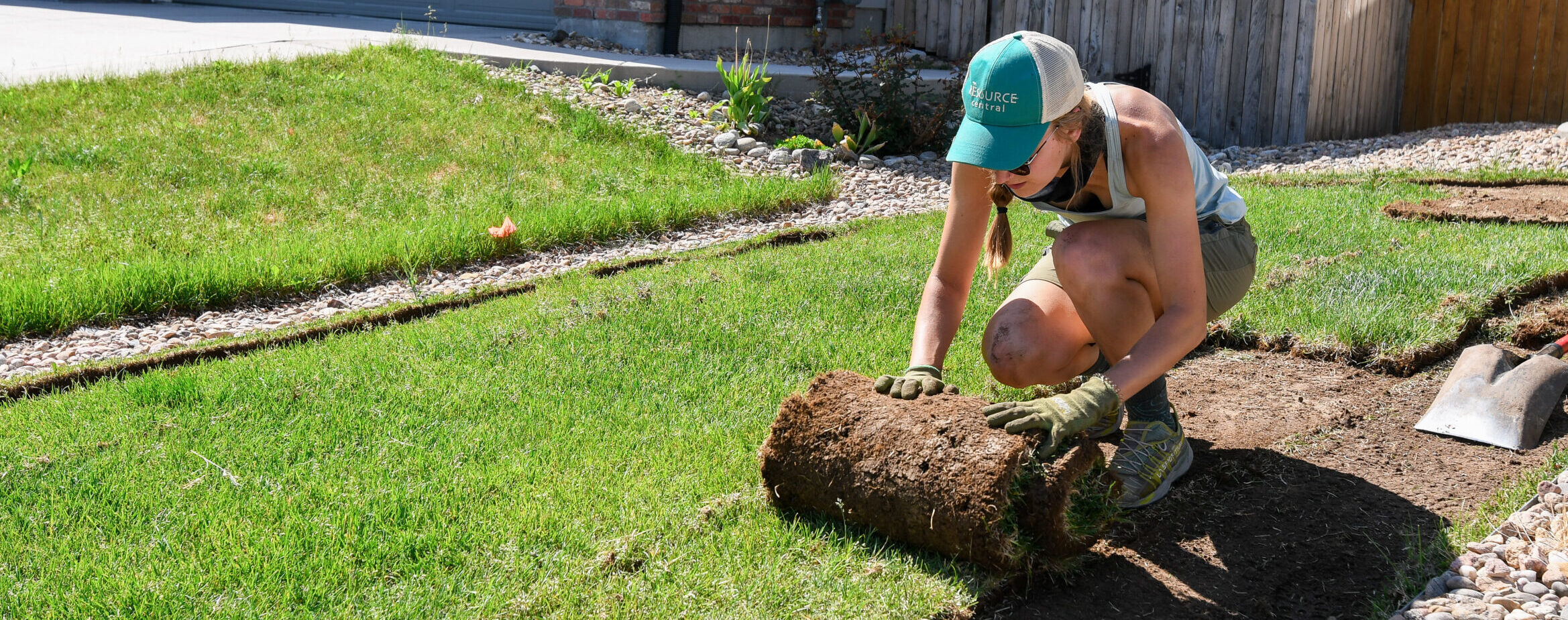1. Sheet Mulching / Lasagna Method
This cost-effective and environmentally conscious approach promises a professionally landscaped result without extensive labor or sod removal. Designed for efficient soil enrichment and home composting, this method ensures a vibrant waterwise garden come summer.
Benefits
- Efficiency – Transform your lawn without extensive effort
- Cost-Effective – Achieve a beautiful garden without a hefty price tag
- Minimal Labor – Say goodbye to strenuous tasks; let nature do the work
- Low Environmental Impact – Embrace a sustainable approach to lawn care
- No Sod Removal/Disposal – Skip the hassle of removing or disposing of sod
- Rich Soil – Build nutrient-rich soil for healthier plant growth
- Home Composting – Provide a space for convenient home composting
Challenges
- Slower Process – Takes about 6-8 months, starting in the fall
- Weeds – This method can promote weed growth
- Not for Steep Slopes – Ideal for flat surfaces, not recommended for slopes
- Not for Large Lawns – Best suited for smaller areas, not extensive lawns
Concerned about newspaper ink? Fear not! Most inks are soy-based and safe for your lawn. Check with your paper provider for peace of mind.
Steps
- Start in the fall. Cut your grass as short as possible. This will ensure that the newspapers or cardboard lay flat in place.
- Spread a 2 inch layer of compost that is high in nitrogen over the area to be replaced. Moisten well.
- Cover the area of lawn that you wish to kill with overlapping cardboard (used boxes will work just fine) or newspaper (10 to 12 sheets thick). Be sure to fully overlap in different directions and that no sunlight can get through, otherwise, the grass will find a way to survive!
- Water the newspaper/cardboard. Be careful not to water too heavily, or the paper may start to tear. You just need it to be wet enough to stay in place and speed up the decomposition process.
- Cover the newspaper/cardboard with another 2 inch layer of compost.
- Top the compost with up to 18 inches of organic materials (grass clippings, leaves, farm manure, straw, food scraps). As time goes on, this pile of organic material will shrink in size, and by spring it will be ready for planting.
- Top it all off with a 4 inch layer of mulch.
- Water the bed occasionally to make for better decomposition.
- Plant in the fall season.
2. Solarization Method
With this method you will cover the area of grass that you wish to eliminate with a black plastic sheet, creating a sun-powered oven for your grass that is an uninhabitable place for it to live.
Benefits
- Efficiency – Transform your lawn without extensive effort
- Cost-Effective – Achieve a beautiful garden without a hefty price tag
- Minimal Labor – Say goodbye to strenuous tasks; let nature do the work
- Low Environmental Impact – Embrace a sustainable approach to lawn care
- No Sod Removal/Disposal – Skip the hassle of removing or disposing of sod
- Composting – Can create compost from your dead grass
- Sunny Areas – Good for hot, sunny areas
Challenges
- Really Slow Process – Can take anywhere from 6 weeks to a year to fully kill your grass
- Unsightly – May have the neighbors wondering when the painting is going to begin
- Not for Steep Slopes – Ideal for flat surfaces, not recommended for slopes
- Shade Areas – Does not work in cool, shady areas
Steps
- Begin the solarization process when spring is turning to summer. In Colorado, this is typically in May and early June.
- Cut your grass as short as possible and water it well to prepare the lawn for the process.
- Cover the lawn area that you wish to kill with a black polyethylene sheet (can be purchased at your local hardware store). Hold the sheet in place with heavy rocks or metal stakes. Make sure that the entire area is covered, and that it is airtight with no leaks or holes. The black plastic will act as a trap for the sun’s radiant heat, and it will kill the grass by heating the top 6 inches of soil to about 140 degrees Fahrenheit. You can use a soil thermometer or temperature probe to verify that the soil is heating as desired.
- Depending on the weather, leave in place for 4 to 8 weeks or until the grass is dead.
- Remove the plastic and leave the dead grass to compost.
- At this point, you have three main options:
- Follow the steps (except step 6) for “Sheet Mulching (Lasagna Method)”, and plant right away (not next spring).
- Depending on how long it has taken to kill the grass and how much time is left in the growing season – you can begin planting right away, but be sure not to cultivate any soil that is deeper than 2 inches! It is possible that weed seeds at deeper levels will surface and grow.
- Wait until next year to plant.
3. Physical Removal
This is a method of physically removing your lawn with a sod cutter or manually with a square shovel or grape grubbing hoe.
Benefits
- Quick – Fastest way to remove lawn
- Compost – The removed sod makes great compost
- Top Soil – Leaves the majority of your soil intact
- Get Fit – If you’re doing it manually, you’ll get a good workout
- Large Areas – Good for areas greater than 100 square feet
Challenges
- It’s a Workout – Very labor-intensive.
- Regrowth – Higher chance of grass regrowth than other methods – sometimes roots and grass clipping will resprout.
- Deep Roots – Will not work for long rooted grasses such a Bermuda Grass – the sod cutter does not remove the roots that reach several feet below the surface.
- Rentals – If you use a sod cutter, this will require a piece of machinery that you likely do not own.
Steps
- Based on the size of the lawn area that you want to remove, decide whether you want to use a sod cutter or a square shovel/grape grubbing hoe. On average, two people can manually remove and haul away 100 square feet of lawn in an hour. If you do not own a sod cutter, and that is the way that you would like to go, then rent one from your local tool supplier.
- Sod cutter – Once you get your hands on a sod cutter, you will simply cut your sod into strips, roll them up, and get rid of them.
- Shovel or hoe – The same steps apply: Dig it up and move it out! Make sure you dig deeply enough to remove the roots – root depth will vary from yard to yard. Getting a friend or neighbor to help you out is highly encouraged.
- Add some compost to your new garden area and get your garden ready for planting. You may want to consider Solarizing (see “Solarization” section) the area to make sure to kill any weeds that may remain in the soil.












